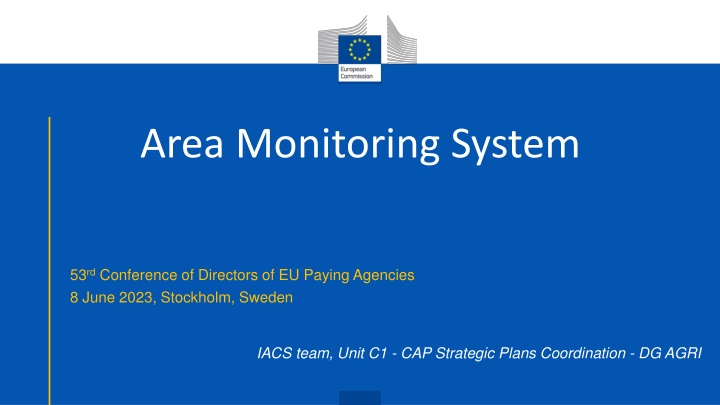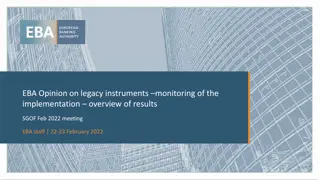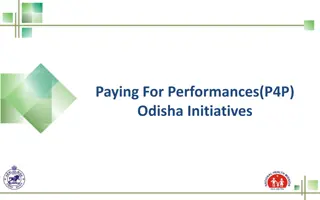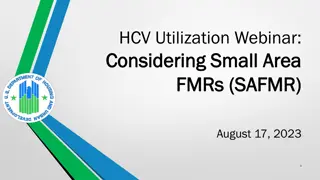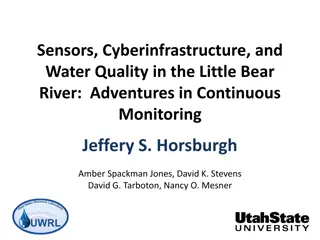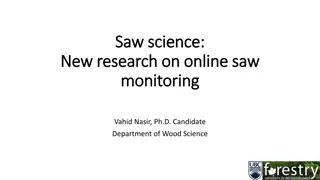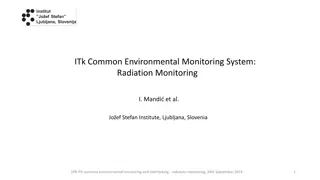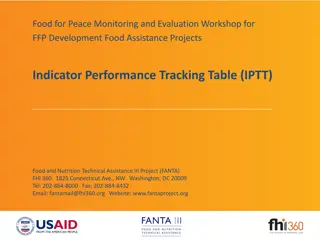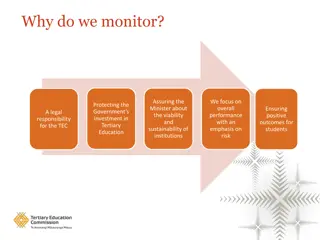Comprehensive Overview of Area Monitoring System Implementation in EU Paying Agencies
The Area Monitoring System (AMS) plays a vital role in assessing agricultural activities in Member States. This system ensures exhaustive coverage, automated processing, and mandatory monitoring of eligibility conditions for area-based interventions. AMS utilizes Copernicus Sentinels satellite data to observe and assess agricultural practices, with the goal of enhancing the effectiveness of CAP Strategic Plans Coordination. The system detects ineligible areas, land use changes, and ensures compliance with eligibility conditions. AMS is a crucial tool for overseeing agricultural practices in the EU.
Download Presentation

Please find below an Image/Link to download the presentation.
The content on the website is provided AS IS for your information and personal use only. It may not be sold, licensed, or shared on other websites without obtaining consent from the author.If you encounter any issues during the download, it is possible that the publisher has removed the file from their server.
You are allowed to download the files provided on this website for personal or commercial use, subject to the condition that they are used lawfully. All files are the property of their respective owners.
The content on the website is provided AS IS for your information and personal use only. It may not be sold, licensed, or shared on other websites without obtaining consent from the author.
E N D
Presentation Transcript
Area Monitoring System 53rd Conference of Directors of EU Paying Agencies 8 June 2023, Stockholm, Sweden IACS team, Unit C1 - CAP Strategic Plans Coordination - DG AGRI
Summary The Area Monitoring System AMS Implementation Status in Member States AMS quality assessment (QA) 2
What is the AMS? Definition: a procedure of regular and systematic observation, tracking and assessment of agricultural activities and practices on agricultural areas by Copernicus Sentinels satellite data or other data with at least equivalent value (R. 2021/2116 Art. 65(4)(b)) Main characteristics : Exhaustive coverage Automated processing Mandatory 4
Exhaustive coverage What should be monitored? All monitorable eligibility conditions (defined by MS in CSP) of all area-based intervention (minimum BISS and ANC in 2023 if MS has technical limitations) What does monitorable mean? Initially : Can be monitored by Copernicus Sentinels satellites data or data with at least equivalent value Later on : Can be monitored by geotagged photos What about non-monitorable eligibility conditions? Not part of AMS, but of AMS QA and control system 5
Exhaustive coverage Monitored by Sentinel : To cover full population : Possible to combine Copernicus Sentinel satellites data with data of at least equivalent value To reduce non conclusive ( yellow ) cases : Possible to perform a cascaded analysis of Sentinel satellite data and/or other types of data with at least equivalent value Monitored by geotagged photos : If no geotagged photo is provided by the applicant upon request, then it should be considered a non-compliance ( red case) 6
Exhaustive coverage Prior to analysis of compliance with eligibility conditions, the AMS should detect: presence of ineligible area, in particular due to permanent structures presence of ineligible land use change in the category of agricultural area whether it is arable land, permanent crop or permanent grassland
Automated processing The AMS should be an automated process Checks by Monitoring Area Monitoring System Eligibility condition Eligibility condition Yellow Yellow Red Green Green Red No follow-up of yellow cases required Manual or semi-automated follow- up of yellow cases possible 8
Ineligible area/land use or change in category Process Eligibility condition OK Copernicus Sentinel data + equivalent value NDVI time series of parcel with winter cereal march june july april may No conclusive result Automatic analysis Eligibility condition NOT OK Geotagged photos Alert to farmer to amend application! 9
Mandatory Member States shall set up and operate an area monitoring system, which shall be operational from 1 January 2023 (R. 2021/2116 Art. 70(1)) Timeline of implementation All monitorable area-based interventions (minimum BISS and ANC in 2023 if MS has technical limitations) Copernicus Sentinel satellites data + equivalent 2023 All monitorable area-based interventions Copernicus Sentinel satellites data + equivalent 2024 All monitorable area-based interventions Copernicus Sentinel satellites data + equivalent + geotagged photos 2025 All monitorable area-based interventions (at least 70% interventions with geotagged photos) Copernicus Sentinel satellites data + equivalent + geotagged photos 2027
AMS Implementation Status in Member States
Survey A survey on the implementation status of the AMS was sent to Member States (MS) end of April Intention : to better understand your diverse situations to better support you in the implementation of the AMS This section provides a short overview of main trends Status : 31 May 2023
Response rate AMS questionnaire 202304: Total answers received 25 23 20 15 10 5 5 0 Answer No Answer
1a 1e: Interventions subject to AMS Many interventions subject to AMS, and fully monitored in some MS Interventions, under AMS, fully monitored 35 30 25 20 15 10 5 0 1 2 3 4 5 6 7 8 9 10 11 12 13 14 15 16 17 18 19 20 21 22 23 24 25 26 27 28 How many interventions are subject to AMS? How many interventions are fully monitored by AMS? (excluding administrative criteria)? If so - which ones?
1a: Interventions subject to AMS in 2023 Intervention types under AMS in 2023 25 BISS CRISS CISYF ECO-Scheme(d) the schemes for the climate, the environment and animal welfare. CIS (a) the coupled income support; CSPC (b) the crop-specific payment for cotton. ENVCLIM (a) environmental, climate-related and other management commitments; ANC (b) natural or other area-specific constraints; ASD (c) area-specific disadvantages resulting from certain mandatory requirements; (a) the basic income support for sustainability; (b) the complementary redistributive income support for sustainability; (c) the complementary income support for young farmers; 20 15 10 5 Rem: groups made for Eco-schemes ENVCLIM CIS ANc ASD ... 0 BISS CRISS CISYF ECO-Scheme CIS CSPC ENVCLIM ANC ASD
2: Geotagged photos Around 40% of MS use already geotagged photos (automatic processing inside of AMS) Does AMS use geotagged photos as input data in 2023? 2.a 22% 39% 39% Yes No No answer
3: Use of external services providers At least 60% of MS use external services providers Do you make use of external service providers to operate the AMS? 3.a 21% 14% 65% Yes No No answer
4: Use of external solutions Relatively low uptake of outputs from EU-funded projects (Niva, Sen4CAP) 4.b Do you make use of solutions provided by the ESA-funded SEN4CAP project? If yes - which ones? 4.d Do you make use of solutions provided by other national or EU-funded projects? If yes - which projects? 4.c Do you make use of solutions provided by the EU-funded NIVA project? If yes - which ones? 17% 21% 14% 22% 62% 14% 21% 64% Yes No No answer Yes No No answer 65% Yes No No answer
5: Geotagged photos as counter evidence Relatively many MS accept geotagged photos serving as counter evidence after yellow or red AMS results Can 'geotagged photos' be uploaded as counter evidence? 5.e 21% 11% 68% Yes No No answer
6: AMS hurdles identified by MS Mostly no issue in accessing cloud services Challenges with recruiting skilled IT staff Some issues with algorithm availability 6.d Is lack of algorithmic solutions hampering the implementation of AMS? If yes - for which conditions? 6.b Is lack of access to cloud services hampering the implementation of AMS? If so - why exactly? 11% 6.c Is lack of skilled IT staff hampering the implementation of AMS? If yes - why (internal or external staff)? 22% 21% 41% 38% 67% 21% 50% Yes No No answer Yes No No answer 29% Yes No No answer
First Impressions Summary based on 23 replies In general, work progresses well with some challenges
AMS QA - Purposes Assess the reliability of the implementation of AMS Provide diagnostic information on the sources of incorrect decisions at the level of interventions and eligibility conditions (e.g., help improve the system) Ensure that the integrated system provides reliable, comprehensive and verifiable data in the annual performance reporting
AMS QA - What should be checked? Sample of parcels covering : all area-based interventions all eligibility conditions (monitorable & non-monitorable) Sample should be the same as the GSA QA
AMS QA - Consequences If the QA reveal deficiencies, MS shall adopt remedial actions If the remedial actions implemented by the MS do not improve the situation in the subsequent year, the MS should submit an action plan to the Commission
R. 2022/1172 Art 5(6) Can the AMS QA contribute to controls? For simplification purposes, MS may decide to take the AMS QA and GSA QA into account in respect to the obligation to set up a control system However, the remaining specific control provisions* should still be ensured by the MS, such as, for example, the risk component of the sample (the samples of the QAs are not risk based samples) For an intervention under AMS for which all ElCo are monitorable and monitored, MS may decide that the obligation to set up a control system is fulfilled for that intervention * at least provisions established in Articles 59, 60 (even if not referred to in Art. 5(6) they do apply to all interventions) and 72 of R. 2021/2116
Thank you Contact : AGRI-IMPLEMENTATION-SUPPORT@ec.europa.eu
